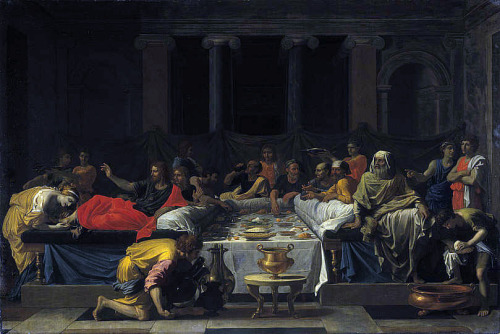#french painting - 17thc
POUSSIN, HISTORY PAINTING AND FRANCE
Nicolas Poussin’s two Seven Sacraments series depict episodes in the ministry of Christ and the apostles held by the church to be the originary moments of each of the seven sacraments (baptism, the eucharist, confirmation, penance, marriage, ordination and extreme unction). The first series was commissioned by Poussin’s Roman benefactor, the antiquarian Cassiano del Pozzo, in 1636, and completed by 1642. The second series was painted for Poussin’s French patron, the courtier Paul Fréart de Chantelou, in 1646-47. Chantelou initially asked the artist to duplicate the first series, but Poussin, who accepted the monumental task only reluctantly, was not interested in retracing his steps and insisted on creating new pictorial compositions for each of the seven subjects.
Despite their theological subject matter, neither series was destined for a liturgical setting or intended to be used for devotional purposes (Chantelou’s canvases were probably destined for his cabinet de peintures, where they would have been set into gilded boisériesin an order not necessarily chronological.
Even though the subject matter was Christian, both patrons would have viewed the works as depictions of the inaugural events that led to the institution of the sacraments, or, as history paintings. The pictures announce their generic status through details of costume and setting. Poussin’s paintings were prized by more learned collectors because the artist went to great lengths to depict period settings, costumes and objects with a high degree of historical accuracy. For example, in the representation of the the Last Supper, which illustrates the institution of the Eucharist, Christ and the apostles recline while dining, as was the ancient custom, and the meal is set in carefully reconstructed Roman triclinium of the type Poussin would have known from ruins visible in Rome. The lamps and sconces seen in the Marriage of the Virgin (Matrimony) are faithful depictions of Roman fixtures found in excavations around the city, and the garments are based on Roman sculpture of the Augustan period.
Poussin is said to be the ultimate “classicizing” painter, but this terminology gives the impression that his primary interest was an abstraction called antiquity per se. It would be more accurate to say Poussin was a history painter who scrupulously mastered and represented the visible details of classical antiquity, not for aesthetic of formal reasons, but because accession to the pictorial genre to which he aspired required the a convincing representation of history, which, in this period conflated with greco-Roman antiquity. was on their ability to historical , which was classical.
This is confirmed by the striking fact that despite being surrounded by the remains of classical art, Poussin rarely quotes explicitly from well-known ancient artworks, as was common practice among his Italian contemporaries. His preferred genre called for the correct rendering of vessels, furniture, garments, hairstyles and weapons all’ antica , but not the Laocoön or the Farnese Bull. his interests were not in antiquity but in history painting. He was not a nostalgic painter fixated on reviving the past, but a modern artist engaged with contemporary academic and theoretical debates about the nature and purpose of painting. Even though he lived in Rome, his intellectual focus was French, and for these reasons his work must be interpreted within the context of French painting.
Post link







